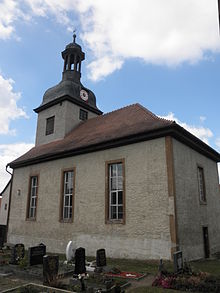Lindig
| coat of arms | Germany map | |
|---|---|---|

|
Coordinates: 50 ° 47 ' N , 11 ° 36' E |
|
| Basic data | ||
| State : | Thuringia | |
| County : | Saale-Holzland district | |
| Management Community : | Southern Saale Valley | |
| Height : | 260 m above sea level NHN | |
| Area : | 4.53 km 2 | |
| Residents: | 225 (Dec. 31, 2019) | |
| Population density : | 50 inhabitants per km 2 | |
| Postal code : | 07768 | |
| Area code : | 036424 | |
| License plate : | SHK, EIS, SRO | |
| Community key : | 16 0 74 052 | |
| Association administration address: | Bahnhofstrasse 23 07768 Kahla |
|
| Website : | ||
| Mayoress : | Petra von der Gönne | |
| Location of the municipality of Lindig in the Saale-Holzland district | ||
Lindig is a municipality in the south of the Saale-Holzland district and part of the administrative association Südliches Saaletal .
history
Lindig was first mentioned in a document in 1368.
In the second half of the 18th century there was an organ workshop in the village. The workshop founder Justinus Ehrenfried Gerhardt , a student of the famous Saxon organ builder Johann Gottfried Silbermann , had immigrated and married a local resident. But the location was given up in the grandchildren's generation and the workshop relocated to Dorndorf.
Population development
|
|
|
|
|
- Data source: Thuringian State Office for Statistics
coat of arms
Description of the coat of arms : "In gold a knight in steel-blue armor who thrusts a black lance into the throat of a green dragon lying on his back."
Attractions
St. Ursula village church
The church in the middle of the village ( location → ) was built in 1733–1735. It emerged from an older church, mentioned on May 1, 1506 in handwritten entry (" ... zcu blintic in der kirche sends ursulen ") in a Latin missal from 1486, which had become dilapidated and too small. In the previous church, the pulpit was built behind the altar in 1580. The church received a bell as early as 1586. From 1605 to 1608 the church was renovated. The church received another bell in 1636. The old font from 1649 was renewed in 1772. The new, larger church received an organ in 1742 from the workshop of Justinus Ehrenfried Gerhard , which was renewed in 1763 by his grandson, Johann Christian Adam Gerhard . The tower received a simple clock in 1753. In 1867 the two old bells were cast in the Apolda bell foundry . The interior of the church and the organ were renovated and repaired in 1875. In 1907 the church was painted and furnished with a picture of Christ on the pulpit and a landscape painting on the organ gallery. The larger bronze bell had to be sacrificed to the First World War ; it was replaced by a new bell in 1929, which, however , had to be delivered during the Second World War in 1942. After the war, damage to the tower, the windows and the tower clock was repaired. On July 17, 1976, lightning struck the tower, causing damage that was not repaired until 1984. In 1991 the church received a new tiled roof and the tower a new slate roofing. In 1996 the church tower clock was overhauled and in 1999 the ceiling of the nave was re-plastered. The church underwent the last comprehensive renovation of the interior of the church between 2001 and 2006, and in 2010 the restored organ was consecrated again.
A carved figure of the namesake, Saint Ursula , with the arrow as her iconographic attribute and the martyr's crown, is located above the altar of the church. Until 1905 the figure was in the attic with two others, it comes from a Gothic carved altar. The statue of Ursula is flanked by the other two figures: Saint Odilia is depicted in a nun's costume and with two eyes on the book in her hand, the other figure is perhaps Saint Dorothea . This is indicated by the flower in her hand, which may have been added later.
The tower, which is drawn in to the center of the nave, has a tail dome, crowned by a large lantern with a tower ball and a weather vane .
In the first years after the Reformation, Löbschütz and Lindig formed their own parish. It was assigned as a Kahla branch around 1537 .
In the churchyard there are three simple wooden crosses over the graves of German soldiers who perished on April 8, 12 and 15, 1945.
Memorials
Since 1974, near the village in Leubengrund ( Lage → ), a monumental memorial has been commemorating the 6,000 victims of forced labor for the armaments production of the REIMAHG . They were deported to Germany during World War II .
Personalities
- Justinus Ehrenfried Gerhard (~ 1710–1786), organ builder
- Christian August Gerhard (1745–1817), organ builder, son of Justus Ehrenfried Gerhard
- Johann Christian Adam Gerhard (1780–1837), organ builder, son of Christian August Gerhard
- Siegfried Woitzat (1933–2008), German soccer player
Individual evidence
- Lindig on the website of the Eisenberg church district.Retrieved January 10, 2017





